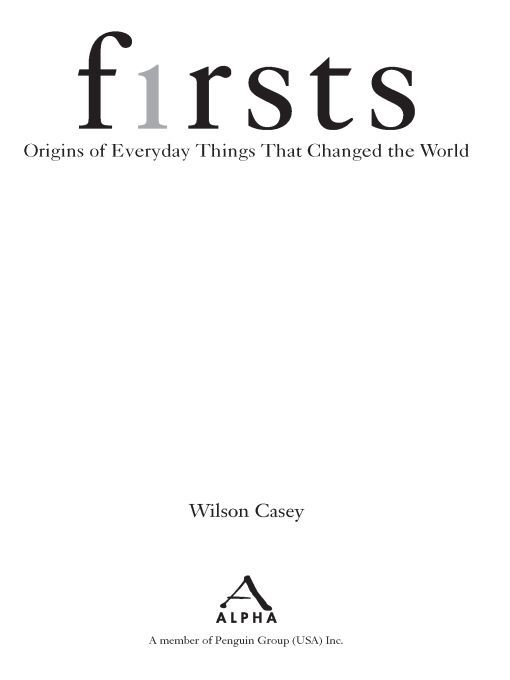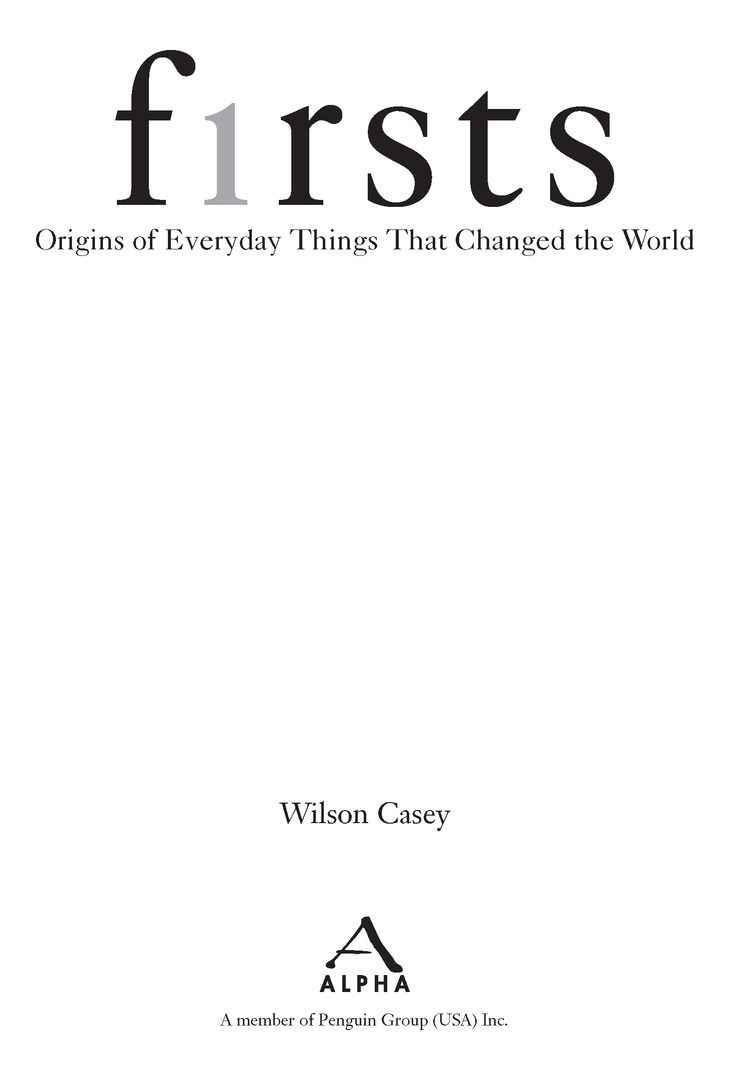Firsts
Authors: Wilson Casey


Table of Contents

ALPHA BOOKS
Published by the Penguin Group
Penguin Group (USA) Inc., 375 Hudson Street, New York, New York 10014, USA
Penguin Group (Canada), 90 Eglinton Avenue East, Suite 700, Toronto, Ontario M4P 2Y3,
Canada (a division of Pearson Penguin Canada Inc.)
Penguin Books Ltd., 80 Strand, London WC2R 0RL, England
Penguin Ireland, 25 St. Stephen’s Green, Dublin 2, Ireland (a division of Penguin Books Ltd.)
Penguin Group (Australia), 250 Camberwell Road, Camberwell, Victoria 3124, Australia (a
division of Pearson Australia Group Pty. Ltd.)
Penguin Books India Pvt. Ltd., 11 Community Centre, Panchsheel Park, New Delhi—110 017,
India
Penguin Group (NZ), 67 Apollo Drive, Rosedale, North Shore, Auckland 1311, New Zealand
(a division of Pearson New Zealand Ltd.)
Penguin Books (South Africa) (Pty.) Ltd., 24 Sturdee Avenue, Rosebank, Johannesburg 2196,
South Africa
Penguin Books Ltd., Registered Offices: 80 Strand, London WC2R 0RL, England
Penguin Group (USA) Inc., 375 Hudson Street, New York, New York 10014, USA
Penguin Group (Canada), 90 Eglinton Avenue East, Suite 700, Toronto, Ontario M4P 2Y3,
Canada (a division of Pearson Penguin Canada Inc.)
Penguin Books Ltd., 80 Strand, London WC2R 0RL, England
Penguin Ireland, 25 St. Stephen’s Green, Dublin 2, Ireland (a division of Penguin Books Ltd.)
Penguin Group (Australia), 250 Camberwell Road, Camberwell, Victoria 3124, Australia (a
division of Pearson Australia Group Pty. Ltd.)
Penguin Books India Pvt. Ltd., 11 Community Centre, Panchsheel Park, New Delhi—110 017,
India
Penguin Group (NZ), 67 Apollo Drive, Rosedale, North Shore, Auckland 1311, New Zealand
(a division of Pearson New Zealand Ltd.)
Penguin Books (South Africa) (Pty.) Ltd., 24 Sturdee Avenue, Rosebank, Johannesburg 2196,
South Africa
Penguin Books Ltd., Registered Offices: 80 Strand, London WC2R 0RL, England
Copyright © 2009 by Wilson Casey
All rights reserved. No part of this book shall be reproduced, stored in a retrieval system, or transmitted by any means, electronic, mechanical, photocopying, recording, or otherwise, without written permission from the publisher. No patent liability is assumed with respect to the use of the information contained herein. Although every precaution has been taken in the preparation of this book, the publisher and author assume no responsibility for errors or omissions. Neither is any liability assumed for damages resulting from the use of information contained herein. For information, address Alpha Books, 800 East 96th Street, Indianapolis, IN 46240.
eISBN : 978-1-101-15946-0
Library of Congress Catalog Card Number: 2009924914
Interpretation of the printing code: The rightmost number of the first series of numbers is the year of the book’s printing; the rightmost number of the second series of numbers is the number of the book’s printing. For example, a printing code of 09-1 shows that the first printing occurred in 2009.
Trademarks:
All terms mentioned in this book that are known to be or are suspected of being trademarks or service marks have been appropriately capitalized. Alpha Books and Penguin Group (USA) Inc. cannot attest to the accuracy of this information. Use of a term in this book should not be regarded as affecting the validity of any trademark or service mark.
All terms mentioned in this book that are known to be or are suspected of being trademarks or service marks have been appropriately capitalized. Alpha Books and Penguin Group (USA) Inc. cannot attest to the accuracy of this information. Use of a term in this book should not be regarded as affecting the validity of any trademark or service mark.
Most Alpha books are available at special quantity discounts for bulk purchases for sales promotions, premiums, fund-raising, or educational use. Special books, or book excerpts, can also be created to fit specific needs.
For details, write: Special Markets, Alpha Books, 375 Hudson Street, New York, NY 10014.
Introduction
History is complicated—everyone is his or her own historian, and it’s often difficult to convince people something other than what they believe is, indeed, true. In real estate, it’s all about location, location, location. You could say that with “firsts,” it’s all about definition, definition, definition.
As a professional researcher, I was amazed at the varied stories I found around firsts. It seems that for every first I could think of—and I thought of more than 500 firsts for this book—there were numerous possible answers as to what came first. If I went to one source I thought highly reliable and then went to another I thought just as reliable, I found two entirely different scenarios. Who was first? Who was
really
first? That source said what? The other one said that? Is that source biased? At times, trying to find the true first was a tough call. Was Jerrie Cobb the first female astronaut? I say yes, because she successfully passed all three phases of the Mercury program tests. Others adamantly say no because she didn’t actually fly in space.
really
first? That source said what? The other one said that? Is that source biased? At times, trying to find the true first was a tough call. Was Jerrie Cobb the first female astronaut? I say yes, because she successfully passed all three phases of the Mercury program tests. Others adamantly say no because she didn’t actually fly in space.
Does this book provide the absolute definitive answers regarding firsts? Absolutely not, but every effort was made to do so. I found many myths, errors, and half-truths I had to decipher. At times, I found blatant lies from sources trying to push their hidden agendas. (Maybe next I’ll write a book debunking many historical “facts.”) The only plausible method to arrive at the true facts would be to hop in a time machine with a staff of qualified and objective bystander-experts armed with camcorders to document the historical events as they happened. As with any research, the information-gathering sources I used may contain errors that I’ve passed on, but the vast majorities of the contents of this book were derived from reliable, historical information pools and expert historians. While some of the entries do represent reasonable deductions, it’s very possible that further research into unpublished accounts of events may disclose additional data.
Another difficulty in determining a true first is due to terminology. An airplane is an aircraft, for example, but so is a balloon; similarly, automobiles used to be called
motorcycles,
and motorcycles used to be called
automobiles
. Among other problems was the simultaneity of several variations of the same invention; the difference between the actual invention and its refinement or development, manufacture, and promotion, leading to conflicts in claims; the inaccuracy or dishonesty of some claims; and the inadequacy of many of the records accepted as documentation for the claims.
motorcycles,
and motorcycles used to be called
automobiles
. Among other problems was the simultaneity of several variations of the same invention; the difference between the actual invention and its refinement or development, manufacture, and promotion, leading to conflicts in claims; the inaccuracy or dishonesty of some claims; and the inadequacy of many of the records accepted as documentation for the claims.
While assembling the firsts, I quickly came to realize that often a lot of people appeared responsible for the same invention, and that nobody knew for sure who did it first. For instance, more than 100,000 patents by many different people and companies were necessary before the first automobile as we know it hit the road. Inventions that took hold of society were rarely the result of a spontaneous flash of genius by one single person. More often, they were built on previous ideas and trials, of which no exact date or individual can always be attributed.
Most often it was either luck, curiosity, or necessity to improve something that led the inventors, trail-blazers, and other first-makers to earn a spot in this book. Of course, some were driven by sheer competition to be the first. Take for instance, Mr. Martin Cooper of Motorola. In 1973, he made the first public telephone call placed on a portable cellular phone. Who did he call? His rival, Mr. Joel Engel, at AT&T’s Bell Labs.
Napoleon Bonaparte said, “History is nothing but a lie agreed upon.” Let me expand on Napoleon’s thoughts: “History is nothing but lies agreed upon by the people in charge at the time.” History, to me, is both truth and illusion. The same realm of thought holds true for determining a first. The credit often went to the inventor with the best publicity agent, the first to process a patent, or the first to tell his local newspaper. Many times the real first was too engrossed in his or her work to market or advertise their developments. Sadly, in many cases those passionate folks got lost in the shuffle of history, without their due credit.
A crackpot is a person to be first with a new idea or invention—until it succeeds and then he or she is a creative genius. This book is sincerely dedicated to the real “first” innovators who did not get listed in history textbooks.
Wilson Casey
“Trivia” Guinness World Record Holder
Spartanburg, South Carolina
“Trivia” Guinness World Record Holder
Spartanburg, South Carolina
Acknowledgments
Many people helped make this book a reality, including but not limited to: the reference librarians of the Spartanburg County Public Library, Spartanburg, SC, and especially Mr. Derrick Lawson; the response team at the organization and website of
www.GotQuestions.org
; the U.S. Secret Service, research department, Washington, D.C.; Mr. Loren R. Anderson, president, Snowmobile Hall of Fame, St. Germain, WI; Mr. Tony Brooks, inspirational motivator, Oak Island, NC; Mr. Deane Brown, retired teacher, Spartanburg, SC; Ms. Nikki Busch, grants and reference librarian, University of Wisconsin-Madison, Madison, WI; my mother, the late Helen L. Casey, possessor of great literary talent and so much more, Woodruff, SC; Mr. Marc A. Catone, writer,
www.groups.google.com/group/1960s
, Ithaca, NY; Mr. Andy Clark, director of Flea Circus Research Library, London, England; Mr. Paul Dinas and Ms. Christy Wagner, editors at Alpha Books, New York City and Indianapolis; Mr. Peter Doyle, MENSA member, Widnes, Lancashire, England; Mr. Peter Elliott, senior keeper, Royal Air Force Museum, London, England; Mr. Dave Evans, Director Society of Fire Protection Engineers (SFPE), Bethesda, MD; Mr. Tom Genova, owner,
www.tvhistory.tv
, Dearborn, MI; Ms. Jane Holeman of
www.kitefestival.com
and Ms. Kay Buesing of
www.worldkitemuseum.com
, Long Beach, WA; Ms. Connie Hollar and Ms. Colleen Casey, special research assistants, Spartanburg, SC; Mr. Jean Jergensen, executive director, and Mr. Paul Peinado, communications coordinator, World Lottery Association, Basel, Switzerland; the late Mr. Glenn Kennington, sports researcher, Spartanburg, SC; Mrs. Karen Lawrence, vice president, Cat Fanciers’ Association Foundation, Inc., Manasquan, NJ; Mr. Jona Lendering, researcher,
www.Livius.org
, Amsterdam, Holland; Mr. Morten Lund, founding editor,
Skiing Heritage,
Accord, NY; Mr. Mike Mangus, historical editor,
www.ohiohistorycentral.org
, Columbus, OH; Mr. Robert Marvy, William Marvy company, Inc., St. Paul, MN; Ms. Lynne Olver, editor the Food Timeline,
www.foodtimeline.org
, Randolph, NJ; Ms. Christina Ratliff, Potter’s Wax Museum, St. Augustine, FL; Mr. Bruton Redding, researcher assistant, Spartanburg, SC; Ms. Rita Rosenkranz, literary agent, New York City; Ms. Meredith Semones, librarian, University of Central Florida, Orlando, FL; Ms. Janice Stillman, editor of the
Old Farmer’s Almanac,
Dublin, NH; Mr. Larry Thompson, chief of communication, and Dr. Thierry Vilboux, Ph.D., National Human Genome Research Institute, Bethesda, MD; Dr. Deno Trakas and Dr. Vivian Fisher (retired) of the English Department, Wofford College, Spartanburg, SC; Ms. Alejandra Vergara, project coordinator, World Lottery Association, Montreal, Canada; and Ms. Amanda Forchilli, Office of New York State Professions, Albany, New York.
www.GotQuestions.org
; the U.S. Secret Service, research department, Washington, D.C.; Mr. Loren R. Anderson, president, Snowmobile Hall of Fame, St. Germain, WI; Mr. Tony Brooks, inspirational motivator, Oak Island, NC; Mr. Deane Brown, retired teacher, Spartanburg, SC; Ms. Nikki Busch, grants and reference librarian, University of Wisconsin-Madison, Madison, WI; my mother, the late Helen L. Casey, possessor of great literary talent and so much more, Woodruff, SC; Mr. Marc A. Catone, writer,
www.groups.google.com/group/1960s
, Ithaca, NY; Mr. Andy Clark, director of Flea Circus Research Library, London, England; Mr. Paul Dinas and Ms. Christy Wagner, editors at Alpha Books, New York City and Indianapolis; Mr. Peter Doyle, MENSA member, Widnes, Lancashire, England; Mr. Peter Elliott, senior keeper, Royal Air Force Museum, London, England; Mr. Dave Evans, Director Society of Fire Protection Engineers (SFPE), Bethesda, MD; Mr. Tom Genova, owner,
www.tvhistory.tv
, Dearborn, MI; Ms. Jane Holeman of
www.kitefestival.com
and Ms. Kay Buesing of
www.worldkitemuseum.com
, Long Beach, WA; Ms. Connie Hollar and Ms. Colleen Casey, special research assistants, Spartanburg, SC; Mr. Jean Jergensen, executive director, and Mr. Paul Peinado, communications coordinator, World Lottery Association, Basel, Switzerland; the late Mr. Glenn Kennington, sports researcher, Spartanburg, SC; Mrs. Karen Lawrence, vice president, Cat Fanciers’ Association Foundation, Inc., Manasquan, NJ; Mr. Jona Lendering, researcher,
www.Livius.org
, Amsterdam, Holland; Mr. Morten Lund, founding editor,
Skiing Heritage,
Accord, NY; Mr. Mike Mangus, historical editor,
www.ohiohistorycentral.org
, Columbus, OH; Mr. Robert Marvy, William Marvy company, Inc., St. Paul, MN; Ms. Lynne Olver, editor the Food Timeline,
www.foodtimeline.org
, Randolph, NJ; Ms. Christina Ratliff, Potter’s Wax Museum, St. Augustine, FL; Mr. Bruton Redding, researcher assistant, Spartanburg, SC; Ms. Rita Rosenkranz, literary agent, New York City; Ms. Meredith Semones, librarian, University of Central Florida, Orlando, FL; Ms. Janice Stillman, editor of the
Old Farmer’s Almanac,
Dublin, NH; Mr. Larry Thompson, chief of communication, and Dr. Thierry Vilboux, Ph.D., National Human Genome Research Institute, Bethesda, MD; Dr. Deno Trakas and Dr. Vivian Fisher (retired) of the English Department, Wofford College, Spartanburg, SC; Ms. Alejandra Vergara, project coordinator, World Lottery Association, Montreal, Canada; and Ms. Amanda Forchilli, Office of New York State Professions, Albany, New York.
Finally, I wish to add a special thanks to all those not listed who gave so unselfishly of themselves. I shall always value their friendship, wise counsel, and generosity.
#
3-D MovieOn September 27, 1922, the earliest confirmed three-dimensional (3-D) film,
The Power of Love,
premiered at the Ambassador Hotel Theater in Los Angeles. The approximately 1-hour film starred Eliot Sparling, Barbara Bedford, Noah Beery, Aileen Manning, Albert Prisco, and John Herdman. The invited audience of “200 scientists, photographers, motion-picture experts, and newspaper men,” according to
Popular Mechanics
magazine, wore anaglyph (3-D) glasses and continually applauded throughout the film, although a glare marred the experience for many viewers.
The Power of Love,
premiered at the Ambassador Hotel Theater in Los Angeles. The approximately 1-hour film starred Eliot Sparling, Barbara Bedford, Noah Beery, Aileen Manning, Albert Prisco, and John Herdman. The invited audience of “200 scientists, photographers, motion-picture experts, and newspaper men,” according to
Popular Mechanics
magazine, wore anaglyph (3-D) glasses and continually applauded throughout the film, although a glare marred the experience for many viewers.

Other books
What if I Fly? by Conway, Jayne
A Spy Unmasked (Entangled Scandalous) by Tina Gabrielle
Surrender Your Grace by Maddie Taylor
Charity's Warrior by James, Maya
Post Apocalyptic Ponies: Revolutions Per Mile, Book 1 by Isherwood, E.E.
BUTTERFLIES FLY AWAY by Mullen, Carol
La caza del carnero salvaje by Haruki Murakami
Sophie Simon Solves Them All by Lisa Graff
A Fistful of Knuckles by Tom Graham
The sword in the stone by T. H. White